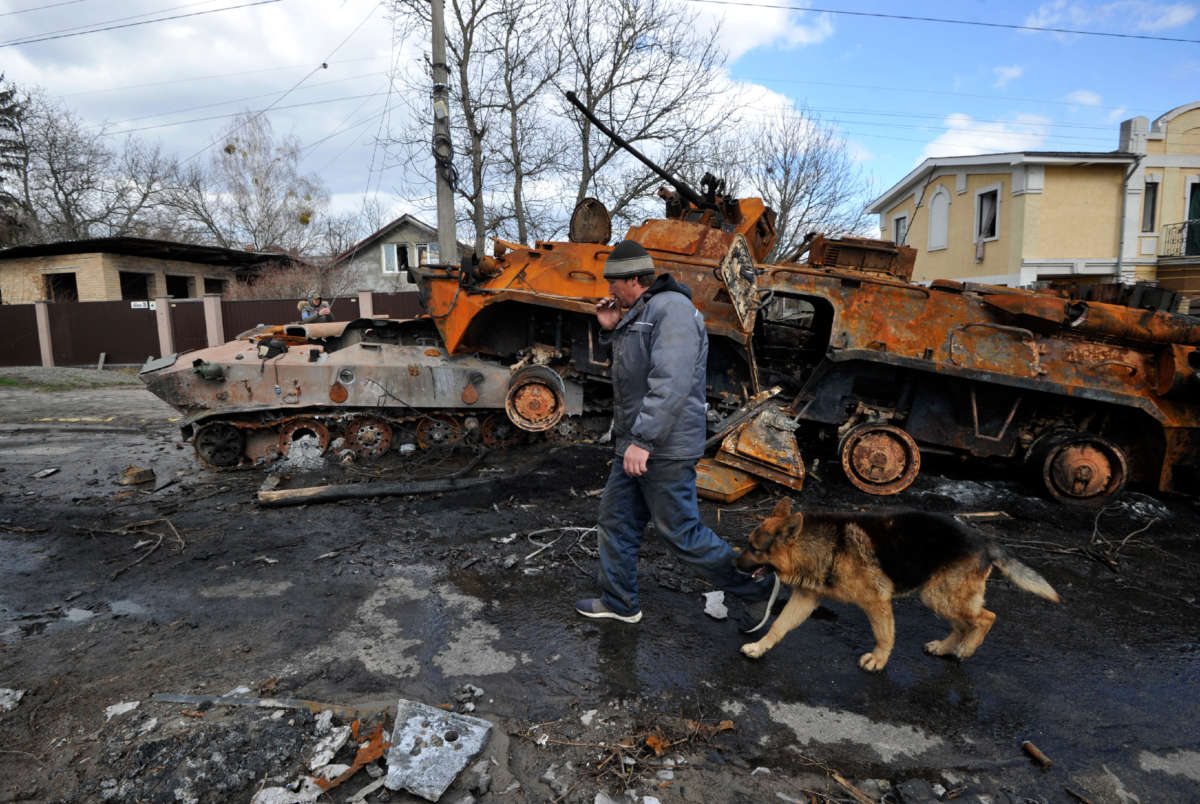The images coming out of Bucha, Ukraine, are harrowing, almost surreal.
A quiet residential street filled with smashed and burned war machines, one appearing to have almost melted into the pavement beside a street sign pointing the way to the supermarket.
Civilians searching desperately for missing loved ones with no idea where or how to begin. In the chaos of this charnel house, anyone could be anywhere, everywhere or nowhere.
A Russian tank turret lies in an open field strewn with smaller debris, the tank it belonged to nowhere in sight, a testament to the unspeakable violence that had been visited upon this town.
A brightly colored schoolyard playground smashed and shredded by artillery shrapnel.
And the bodies, many face down in the street with hands bound, others evidenced only by feet sticking out of hastily prepared mass graves.
Ukraine President Volodymyr Zelenskyy places the civilian death toll in Bucha at more than 300 people. Many of the dead were tortured first. Some of the carnage came as Russian forces retreated from the region around Kyiv in an attempt to reset and restart their shambolic invasion. Spokesmen for Russia’s Ministry of Defense denied the accusations, calling them a “hoax” and claiming the killings took place after Russian forces left town, but an analysis of satellite imagery shows that many of the dead had been lying in the streets for weeks.
The worst, apparently, may be yet to come. Iryna Venediktova, Ukraine’s prosecutor general, spoke on Ukraine’s national television network on Monday. “Venediktova said the number of victims in Borodyanka, around 23km west of Bucha, would be higher than anywhere else,” reports the Guardian, “but did not provide further details.”
“We can speak of Kyiv region because yesterday we got access to these territories and are currently working in Irpin, Bucha, Vorzel,” said Venediktova. “In fact, the worst situation with civilian victims is in Borodyanka. I think we will speak of Borodyanka separately.”
The bulk of photographs revealed to date were taken by press photographers who braved the war to capture those truths. They needed you and I to know what had happened there, and like any good journalist laboring under duress, they got the job done.
Joseph Galloway, widely considered the “dean” of war correspondents by his peers until his death in 2021, first confronted combat in the Ia Drang Valley of Vietnam in 1965. He described the experience to NPR’s Terry Gross:
Men next to me fell over with a bullet in the head. I was lying down as close to the ground as I could get, seemed like the right thing to do.
When I felt the toe of a combat boot in my ribs, and I sort of turned my head and tilted up and looked, and it was the battalion sergeant major, a man 6’3″ tall, a big bear of a guy. And he bent over at the waist and sort of yelled down at me so I could just hear him. And what he said shocked me. He said, sonny, you can’t take no pictures laying down there on the ground.
And I thought about that for a minute. And I realized he’s right. I can’t do my job down here. And the other thing that crossed my mind is I think we’re probably all going to be killed. And if that’s the case, I’d just as soon take mine standing up anyway. So I got up and went about my business.
Bucha has joined a long list of places where horrors have been visited upon the innocent, only to be exposed by the journalist’s pen or the photographer’s eye. My Lai, Srebrenica, the Mau Mau rebellion in Kenya, Rwanda, the Disappeared of Argentina. The difference between those tragedies and Bucha is the accelerated speed of the story of its plight going global.
“Bill Clinton regretted he did not respond to the murders of Tutsis in 1994,” reports Patrick Wintour for the Guardian, “saying he did not ‘fully appreciate the depth and the speed with which [Rwandans] were being engulfed by this unimaginable terror’. Srebrenica was arguably only the culmination of ethnic cleansing that had been going on for three years. My Lai, revealed two years after the event, only provided further momentum to a pre-existing US anti-war movement. The scale of the British repression of the Mau Mau rebellion was only truly documented decades afterwards by a Harvard historian Caroline Elkins in her book Britain’s Gulag.”
This time, it was different. The work of those journalists in the war zone of Ukraine rattled the world this week. Hopefully they will remind us all of the brutal human impact of war, beyond its politics.
To be sure, war photography can be used for ill — to whip up nationalism, xenophobia and militarism. But, given the right context, it can bring humanity back into the picture, and illuminate the deep and harrowing human toll of mass violence.
Documentation can be resistance.
Join us in defending the truth before it’s too late
The future of independent journalism is uncertain, and the consequences of losing it are too grave to ignore. To ensure Truthout remains safe, strong, and free, we need to raise $43,000 in the next 6 days. Every dollar raised goes directly toward the costs of producing news you can trust.
Please give what you can — because by supporting us with a tax-deductible donation, you’re not just preserving a source of news, you’re helping to safeguard what’s left of our democracy.
